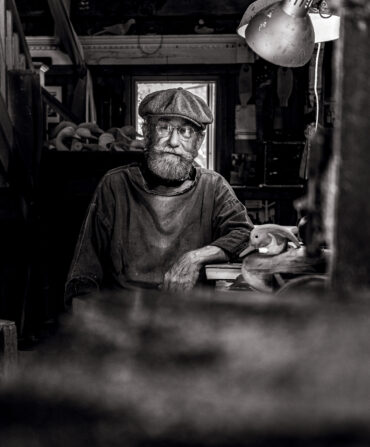Sporting
Field of Dreams
A Swedish-born shotgun virtuoso transplants the European driven shoot to the American West

Photo: ANDY ANDERSON
Jennifer Magnusson and gamekeeper Mattias Jonsson demonstrate proper driven-shooting form at Blixt & Co., near Driggs, Idaho.
Jennifer Magnusson emerges from the back of a walk-in closet, holding a set of Scottish tweed breeks, a couple of pressed gingham and houndstooth shirts and ties, and a tweed blazer that calls to mind the New England boarding school where I’d similarly undershot the dress code. “It’s a little formal for Idaho,” she says. “What size are you?”
Jennifer, a native of Jackson Hole, Wyoming, along with her husband, the Swedish-born shooting instructor Lars Magnusson, own and run Blixt & Co., an operation focused on driven shooting, just west of the Teton Range in the rolling farmland near Driggs, Idaho. If the term driven shooting isn’t immediately familiar, that’s because unlike in the United Kingdom, where it became popular along with such other gilded nineteenth-century estate pastimes as foxhunting and polo, the sport remains an anomaly in the United States.
In driven shooting, unlike the walk-up hunts of Southern quail plantations, a dozen or more people (known as beaters) literally beat the bushes of a cultivated field or stretch of woods in an attempt to fly the resident game birds over, often, a ravine where shooters (called the guns) are positioned at eight marked pegs. Each shooter has a loader—in this case one of four college students from BYU–Idaho—who dishes soupçons of advice and stands constantly ready to slap a fresh gun into a waiting palm. Behind the guns and the loaders sit eight dog handlers, each with one or more British Labrador retrievers whose job it is to sit quietly through the thirty-minute fusillade and then gather up the birds.

Photo: ANDY ANDERSON
Bottom, clockwise from top left: Lars Magnusson and Breeks watch a drive unfold; pheasant on the game cart; Coal at the ready; a flush of partridge.
I’ve spent the last nine years training a yellow Labrador named Cooper, from the same kennel—Wildrose, in Oxford, Mississippi—that supplies Blixt its retrievers, and I’ve been hearing about driven shooting for years. It produces a level of chaos that will test the steadiest dogs and wing shooters. Coop and I have come to see it all, the dogs, the guns, the beaters, and the birds—a forty-person pageantry of the partridge, a century and a continent out of place.
After a breakfast of eggs over arugula, our shooting party speeds west in a caravan of black Range Rovers toward one of two properties the Magnussons have leased and licensed as game preserves. When we arrive, the group, including a British banker, a Spanish pro golfer, an Ohio businessman, and a Jackson Hole landscape photographer, climb into a wooden carriage built onto the back of a 1964 military Deuce and a Half. (Suffice it to say, the singularity of this experience requires no small expense. Yachts, private jets, and the Permian Basin seem to be recurring dinner topics.)
At our first drive, named Skåne, after a region of southern Sweden, Lars shoulders a pair of matching leather-cased Berettas and says he’ll be loading for me. He drops two cartridges into a 20-gauge and reminds me of the need to see blue sky around each bird because of the beaters up in the timber. But as soon as the first flurry of birds skim into view, I forget everything and fire at a partridge banking through the canopy and miss.

Photo: ANDY ANDERSON
Loader Tyler White watches the sky as one of the guns takes aim.
“A little higher next time,” Lars cautions. He’s an imposing figure at six foot one and 190 pounds with a red Viking mane and a Swedish accent. Lars, who is forty-three, discovered shotgunning as a teenager on a farm near his home in Kvibille, Sweden. He’s a gifted shooter himself, wielding a sub-gauge with the confidence of an orchestra conductor, but what he really excels at is teaching others. At twenty, he became one of the first non-British staff instructors at the famous West London Shooting School. He moved to the United States in 2003 to run the shooting school at Griffin & Howe’s Hudson Farm in Andover, New Jersey.
It was 2006, just before the housing crisis, when a group of investors who wanted his help to develop a sporting club lured him to the Tetons. That’s when he met Jennifer, then a graphic designer in Jackson Hole who was helping with the marketing. Lars suggested to the developers that they try driven shooting.

Photo: ANDY ANDERSON
Jennifer Magnusson in between drives.
To Jennifer, it seemed an unlikely prospect. “When Lars first told me that he was going to have people in suits and ties shooting birds in Idaho,” she says, “I laughed out loud.”
They got married in 2008. It was the midst of the recession, and the original partners decided to go in a different direction. Lars thought that if he and Jennifer could sell twelve driven days, they could lease the property and put the shoot on themselves. If they couldn’t, they’d face financial ruin.
“We sold eight that year,” he says. But they survived by living in a shed built to house a generator (dubbed the “love shack”) on the first property that they leased. “I served the meals and cleaned the rooms,” Jennifer says. “We had a chef, a gamekeeper, and us. That was it.”
I typically get in a few days of pheasant and duck hunting each year, mostly on public land, and can usually hit the back of a flying rooster. My fears that driven shooting would seem canned are quickly put to rest as I miss birds descending, banking, and juking from all directions forty yards above me. The birds come in trickles and bursts, singles and whole coveys.

Photo: ANDY ANDERSON
A team of beaters at work reach the crest of a hillside.
From his perch off my right shoulder, Lars calls out my misses. “Behind him…double that lead.” Even the best shooters are only hitting every fourth bird. Between volleys, Lars offers wisdom that sticks.
“Bring the front of the gun up on the bird, then establish a lead,” he says. “You need to create a relationship with the bird before you shoot.” With the birds generally coming at me or going straight over the top, because of the speed and distance, they’re sometimes completely covered by the barrels when I pull the trigger. But finding the bird first and then twitching out to three or four feet of lead makes them begin to drop. Cooper sits by us, watching.
After lunch and a nip of sloe gin, we head out again. This time I go with the beaters, who are led by John Stutchbury. He’s a thirty-four-year-old fourth-generation English gamekeeper from Lancashire with a thick accent. Unable to find gamekeepers in the United States, Lars imported them from abroad.

Photo: ANDY ANDERSON
Walking out to the pegs before one of the day’s drives.
He also imports French-bred red-legged partridge, which along with pheasant are planted in August and encouraged to stay on the property with ample food and water. When I ask just how many birds he plants, he says that’s a little like “asking a lady her weight.” He tells me that they donate thousands of pounds of partridge and pheasant sausage to a local food bank each year. The guns are always welcome to take home their game as well.
During the drive, the beaters carefully choreograph their movements with radios, calling out the position of the birds: “We’re loading up our corner,” Stutchbury advises Lars, signaling that a big flush is about to occur. The beaters closest to the guns wear orange vests. They also carry white flags made from feed sacks that they’ll snap to attention in order to turn an airborne partridge into the firing line. It’s hot, noisy work. And then there’s the gunfire. Being a beater is initially more jarring than hunting a public duck pond on opening morning. The volleys are constant.
“Have you ever been peppered?” I ask Stutchbury.
“If they’re too close,” he says, “I scream at ’em.” I don’t mention my low blow on my first drive.
A few minutes later, a swarm of pellets whiz overhead. “Keep those shots up!” Stutchbury shouts.
The next day, Cooper and I join Wildrose’s owner, Mike Stewart, behind the guns. Driven shooting emerged in the mid-nineteenth century with the invention of breech-loading double-barreled guns. With it, a particular breed of dog—descended from the lesser Newfoundland, or St. John’s dog—began to take shape around these hunts and a few noble kennels. The breed was called the Labrador retriever, and it quickly became the preferred dog for driven shoots because
of its calm demeanor and its ability to recover downed birds in difficult terrain. As Colonel Peter Hawker wrote in his 1814 treatise Instructions to Young Sportsmen in All that Relates to Guns and Shooting, “For finding wounded game, of every description, there is not his equal in the canine race.”

Photo: ANDY ANDERSON
Kyle, a British Lab, retrieves a bird.
Stewart and his Wildrose Kennels handlers are among the best breeders and trainers of British Labs in the United States and have developed a cultish following. I’m convinced that Cooper understands complete English sentences. For Stewart, Blixt represents the rarest of opportunities to steady a finished dog under an endless rain of game birds. There’s nowhere else in the country where eight guns will down several hundred with thousands of shots fired in two days.
“It’s a good place for a finished dog, but not a started one,” Stewart says. When there are lulls in the shooting, he and the other handlers send their dogs by name. Jennifer sits behind one of the guns, holding her daughter, Emilia (with earmuffs), in one arm while handling the Magnussons’ black Lab Breeks with the other. Even in the midst of gunfire, the dogs generally stop when the handler whistles and take hand signals to help them find lost birds. At lunch, the handlers and dogs return to the previous drives and recover an additional twenty-six birds that would have otherwise been lost.

Photo: ANDY ANDERSON
Mattias Jonsson with Angus; colorful pheasant plumes.
What sticks with me most from the shoot is that the human brain doesn’t record the misses. In my mind I can only play back those impossible moments of serendipity when lead cloud and partridge reach the same patch of empty sky at exactly the same instant. Standing at that first peg, it occurs to me that driven shooting is both decadent and highly addictive. It essentially allows you to distill what might normally be an entire season’s worth of wing shooting into thirty minutes.
“It’s sort of like the crack cocaine of wing shooting,” I offer Lars.
“It’s a slippery slope, indeed,” he replies.







